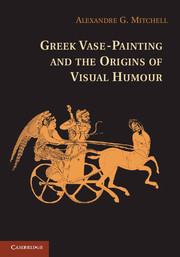Book contents
- Frontmatter
- Epigraph
- Contents
- List of Illustrations
- List of Tables
- Preface
- Acknowledgements
- Abbreviations
- GREEK VASE-PAINTING AND THEORIGINS OF VISUAL HUMOUR
- One Introduction
- Two Humour in the City
- Three Humour in the City
- Four Satyrs and Comic Parody
- Five Caricatures inAthens and at the Kabirion Sanctuary in Boeotia
- Six Conclusion
- Glossary
- Bibliography
- Index of Vases Cited in the Text
- General Index
Preface
Published online by Cambridge University Press: 05 January 2014
- Frontmatter
- Epigraph
- Contents
- List of Illustrations
- List of Tables
- Preface
- Acknowledgements
- Abbreviations
- GREEK VASE-PAINTING AND THEORIGINS OF VISUAL HUMOUR
- One Introduction
- Two Humour in the City
- Three Humour in the City
- Four Satyrs and Comic Parody
- Five Caricatures inAthens and at the Kabirion Sanctuary in Boeotia
- Six Conclusion
- Glossary
- Bibliography
- Index of Vases Cited in the Text
- General Index
Summary
Preface
What is a study of ancient visual humour? It is an archaeology of humour, a study of humorous artefacts, rather than verbal humour. My intention is to attempt to recover ancient Greek visual humour, and as far as possible, its social context. It is also an archaeology of knowledge: taken as a metaphor, it is the logical unlayering of strata of meaning and rubbish, of twists and turns in order to recover some social truths deformed by humour. In Umberto Eco’s Name of the Rose (1982), a Benedictine monk is terrified by Aristotle’s apology of humour in the second book of his Poetics. The book is now lost, and this is probably a good riddance. A few sentences on humour by Plato, Aristotle, Cicero, and Quintillian have somehow formalised the way ancient humour is studied, and their influence is still palpable within each new theory on humour. Luckily, we have always had Aristophanes and many humorous passages in Greek literature to counterbalance these theoreticians. Visual humour offers yet another way to study ancient Greek humour and, by extension, ancient Greek society. By further extension, it may help us retrace some of our own categories of thought. The concluding chapter on humour as a means of social cohesion also deals with the issue of freedom of expression and with the special relationship between humour and democracy.
I first had the idea of studying visual humour in ancient Greece in 1995 for my master’s degree at the University of Strasbourg under the supervision of Prof. Gérard Siebert. I chose this subject because as a student of classics and archaeology I could not believe that, in the world populated by Aristophanes and his many followers, the visual arts did not express similar forms of humour. I could not believe that all was serious, well-balanced, aesthetically pleasing, and stony white in ancient Greek art. Hopefully, the reader will feel the same way after reading this book.
- Type
- Chapter
- Information
- Greek Vase-Painting and the Origins of Visual Humour , pp. xvii - xxPublisher: Cambridge University PressPrint publication year: 2009



